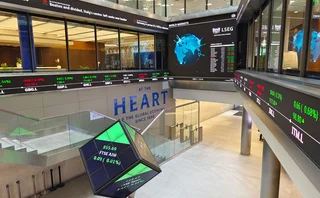
OTC trading platform of the year: Trad-X
Risk Awards 2019: From a D2C Clob to CCP-specific pricing, Trad-X isn’t scared to rock the boat

One of the questions posed by post-crisis reform of the derivatives market has never really been settled: would buy-side firms use a central limit order book, or Clob, for swaps?
In the US, swap platforms are required to offer Clobs as well as the request-for-quote (RFQ) protocol that mimics traditional phone-based trading, and both models are supposed to be open to all participants. Despite this, the market’s traditional split is replicated in the electronic world: dealers and clients meet via RFQ at Bloomberg and Tradeweb, but broker-run Clobs are used only by dealers to hedge those trades.
One of those brokers, Tradition, is now trying to prove it doesn’t have to be that way. Its platform, Trad-X, has been quietly drumming up interest in a dealer-to-client Clob, and the first trades are expected to happen before the end of the year.
“Looking at the market, we could see dealers trading together on the Clob and clients trading with dealers by RFQ or voice, but there was no dealer-to-customer order book. This initiative will provide an alternative to voice trading and RFQ, and the opportunity to trade anonymously on irrefutable prices without market impact,” says Philippe Dudon, global head of business development at Trad-X.
Having engaged with roughly 60 non-dealers, including second-tier banks, asset managers, pension funds, hedge funds and official sector entities, Trad-X is now in the process of onboarding 30 of those firms to its new order book and has three dealers committed to streaming prices, with another three set to join soon.
It may not fly – both dealers and clients have accused each other of throwing sand in the gears in the past – but the willingness to try something new is characteristic of Trad-X.
“When Trad-X went live in 2011, we hadn’t ever seen anything quite like it,” recalls Dan Marcus, the platform’s chief executive. “Interest rate swaps had been one of the largest and darkest markets in the world and suddenly we had 10 banks using exchange-grade technology to stream liquidity in multiple tenors.”
Today, Trad-X is not the biggest of the broker-run OTC platforms by volume, but users credit it with a greater degree of creativity than its rivals.
“Trad-X is the most innovative out there – they are well-positioned with a robust platform, credible liquidity and they very quickly come up with answers to our needs,” says a senior rates trader at one European bank.

An e-trading specialist at another European bank points to two specific innovations: it was the first of the platforms to show specific prices for swaps cleared at Eurex, and it was also a pioneer in creating the market for clearing house basis trades.
“They were really proactive and did this before the others. They were trying to stand out – and they succeeded,” he says.
The basis arises because central counterparties (CCPs) collect margin from users on the basis of the riskiness of their cleared portfolio, meaning identical trades sent to two different CCPs may generate different margin numbers. When a basis first appeared between CME and LCH for US dollar swaps in 2015, it was quickly followed by so-called ‘switch trades’, through which dealers could flatten their positions – Trad-X was one of the pioneers in a market now generating a steady flow of business.
“We became aware early on that banks were servicing some of their clients using CME-cleared swaps, which left them with an unequal open interest position between their CME exposure and their interbank LCH exposure. Since we launched our switch trade service, it has become a significant proportion of our business,” says Dudon.
And overall volumes at the platform have been climbing this year, following the introduction of the second Markets in Financial Instruments Directive (Mifid II) in Europe in January 2018. The number of trades on the European venue has grown by 33% from 21,500 in 2017 to 28,500 in 2018, and by 26% on its US cousin, rising from 67,300 to 85,000. Two new liquidity providers have also been added in the past year – taking the total to 16, from 10 at launch.
“This has been our most significant year yet, because Mifid II has driven a significant increase in our electronic volume, particularly in euros, and we have seen an increase in both the quality and quantity of liquidity on Trad-X. Our engagement with the market has really started to pay off and we feel very confident about our position,” says Marcus.
With Mifid II now implemented, Trad-X might be considered a mature platform with no major changes required, but the prospect of Brexit has thwarted this dream for many large market infrastructures. Trad-X has chosen to establish a new multilateral trading facility (MTF) in Paris to ensure the continuation of euro swaps trading after Brexit, whatever the terms of the UK’s withdrawal.
“We will provide euro and sterling swap capabilities on both the French and UK MTFs, but we expect the primary liquidity for euros to shift to our French MTF,” says Marcus.
Only users who have a paid subscription or are part of a corporate subscription are able to print or copy content.
To access these options, along with all other subscription benefits, please contact info@risk.net or view our subscription options here: http://subscriptions.risk.net/subscribe
You are currently unable to print this content. Please contact info@risk.net to find out more.
You are currently unable to copy this content. Please contact info@risk.net to find out more.
Copyright Infopro Digital Limited. All rights reserved.
As outlined in our terms and conditions, https://www.infopro-digital.com/terms-and-conditions/subscriptions/ (point 2.4), printing is limited to a single copy.
If you would like to purchase additional rights please email info@risk.net
Copyright Infopro Digital Limited. All rights reserved.
You may share this content using our article tools. As outlined in our terms and conditions, https://www.infopro-digital.com/terms-and-conditions/subscriptions/ (clause 2.4), an Authorised User may only make one copy of the materials for their own personal use. You must also comply with the restrictions in clause 2.5.
If you would like to purchase additional rights please email info@risk.net
More on Awards
Clearing house of the year: LCH
Risk Awards 2025: LCH outshines rivals in its commitment to innovation and co-operation with clearing members
Best use of machine learning/AI: CompatibL
CompatibL’s groundbreaking use of LLMs for automated trade entry earned the Best use of machine learning/AI award at the 2025 Risk Markets Technology Awards, redefining speed and reliability in what-if analytics
Markets Technology Awards 2025 winners’ review
Vendors jockeying for position in this year’s MTAs, as banks and regulators take aim at counterparty blind spots
Equity derivatives house of the year: Bank of America
Risk Awards 2025: Bank gains plaudits – and profits – with enhanced product range, including new variants of short-vol structures and equity dispersion
Law firm of the year: Linklaters
Risk Awards 2025: Law firm’s work helped buttress markets for credit derivatives, clearing and digital assets
Derivatives house of the year: UBS
Risk Awards 2025: Mega-merger expected to add $1 billion to markets revenues, via 30 integration projects
Interest rate derivatives house of the year: JP Morgan
Risk Awards 2025: Steepener hedges and Spire novations helped clients navigate shifting rates regime
Currency derivatives house of the year: UBS
Risk Awards 2025: Access to wealth management client base helped Swiss bank to recycle volatility and provide accurate pricing for a range of FX structures







